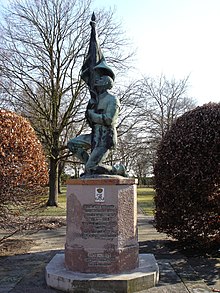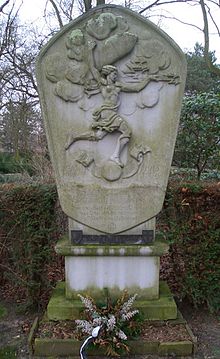Columbiadamm cemetery



The state-owned Columbiadamm cemetery is located in the Berlin district of Neukölln , Columbiadamm 122–140. It already had a few names, beginning with the cemetery behind the Hasenheide , Dennewitz cemetery , from 1861 the new garrison cemetery (to distinguish it from the old one), after 1919 the garrison cemetery , since the 1970s the official cemetery at Columbiadamm , sometimes also at the cemetery at Columbiadamm . It is 104,044 m² in size and currently houses around 7000 graves.
history
After Friedrich Wilhelm IV decided to withdraw his garrison from the narrowness of the city and to accommodate them in new barracks on Tempelhofer Feld , which had always been used as a drill and military training area, the existing small cemetery behind the Hasenheide was opened included and expanded into the new garrison cemetery from 1861 . He donated a cemetery chapel, which he also had a creative influence on. In 1866, his successor, King Wilhelm , left a small strip, the still existing Turkish Cemetery in Berlin , to the Sultan Abdul Aziz for his embassy staff and all Muslims in the growing capital of Prussia.
The fallen soldiers of the wars of 1866 , 1870/71 and especially 1914/18 ensured continuous occupancy, in peacetime officers were happy to have expensive hereditary burials built - in keeping with the style of the time.
The garrison was dissolved, probably as a result of the Treaty of Versailles . From 1922 the barracks were partially demolished and the construction of Tempelhof Airport began. The cemetery remained because there are protected war graves on it (cf. Graves Act ).
Monuments
Members of various regiments have erected a total of ten monuments of different quality on the spacious area to commemorate their fallen comrades. Most of these date from the 1920s and were partially supplemented by memorial plaques for those who died in the Second World War.
The most artistically significant monument is likely to be the monument to those who fell in the wars of 1866 and 1870/71. It comes from Johannes Boese (1888) and is considered his main work. A life-size Prussian soldier lowers his flag as he mourns for his comrades who have been killed. Right next to it is a memorial at the same height and from the same time for around 50 French soldiers who died of their injuries in Berlin hospitals.
Another monumental memorial is dedicated to the fallen of Queen Augusta Guard Grenadier Regiment No. 4 . The work of art made of black syenite dates from 1925 and was created by Franz Dorrenbach . A helmet lies on a flag under which the contours of a man can be seen. The man's clenched fist is visible under the cloth.
The cemetery has the character of a park. After 1945, graves were leveled in large parts of the area and replaced by small memorial stones made of brick, as can be found in most other Berlin cemeteries. However, a number of culturally and art-historically interesting graves have been preserved. Some grave fields have been cleared for the Neukölln population, on some the civilly and militarily deceased lie side by side.
With the first deaths of the first generation of Turkish guest workers, there was a need for a Muslim cemetery in Berlin. For this purpose, part of the former military cemetery for the Muslims who died was designated.
Graves of famous personalities
(* = Honor grave of the state of Berlin)
- Günter Elsner * (1916–1992), German politician
- Hermann Fricke († 1904), fusilier , was killed in a civil rescue act, memorial stone on the Lichtenstein Bridge
- Günter Bruno Fuchs (1928–1977) *, poet and graphic artist
- Community grave for the 29 crew members of the naval airship L 2 , which had an accident at Berlin-Johannisthal Airport on October 17, 1913
- Kurt Gencke († 1941), poet
- Viktor Karl Ludwig von Grumbkow-Pascha († 1901), adjutant general of the Sultan
- Wilhelm von Hahnke (1833–1912), Field Marshal General
- Eduard von Hartmann * (1842–1906), philosopher
- Franz von Hinüber († 1929), ex-Minister of State of the Principality of Reuss
- Eugen Kling († 1897), captain, Africa explorer
- Paulus Klüpfel (1876–1918), founder of the Freiland -freield-Bund
- Curt von Knobelsdorff (1839–1904), co-founder of the Blue Cross , Lieutenant Colonel a. D.
- Eduard von Knorr (1840–1920), Admiral
- Hans von Kretschmann (1832–1899), General of the Infantry, father of the women's rights activist Lily Braun , née von Kretschmann
- Gustav von Lauer († 1889), personal physician to Kaiser Wilhelm I for over 44 years .
- Balduin Möllhausen * (1825–1905), writer
- Hermann von Petersdorf († 1929), historian and Prussian state archivist
- Bernhard von Poten († 1909), military writer
- Moritz von Prittwitz and Gaffron (1795–1885), infantry general and inspector general of all Prussian fortresses
- Emma von Schirach (1872–1944), mother of Baldur von Schirach
- Rudolf von Schön (1810-1891), Prussian general of the cavalry
- Adolf Siemens (1811–1887), cousin of Werner von Siemens , inventor
- Hugo von Waldeyer-Hartz (1876–1942), naval writer
- Francesco Valentini (1789–1862), language teacher, Italianist and lexicographer
gallery
Community grave with anchor for the 28 naval airmen from the L 2 ( LZ 18 ) who died in 1913
Grave of Günter Bruno Fuchs
Honorary grave of the philosopher Eduard von Hartmann
Balduin Möllhausen's grave
Herero stone with Namibia commemorative plaque
See also
literature
- The inauguration of the cemetery in the Hasenhaide near Berlin . In: Illustrirte Zeitung . No. 15 . J. J. Weber, Leipzig October 7, 1843, p. 225-226 ( books.google.de ).
- Wilhelm Borchert: Garrison Cemetery Hasenheide in words and pictures . Berlin 1930
- Karl-Robert Schütze: From the Wars of Liberation to the End of the Wehrmacht - The History of the Garrison Cemetery on the edge of the Hasenheide in Berlin-Neukölln . Berlin 1986
- Arndt Beck, Markus Euskirchen: The buried nation - “Fallen” commemorations from 1813 until today . Berlin 2009
Web links
- Columbiadamm cemetery
- New garrison cemetery and Turkish cemetery
- Entry in the Berlin State Monument List: Garrison Cemetery
Individual evidence
Coordinates: 52 ° 28 ′ 53 ″ N , 13 ° 24 ′ 34 ″ E





